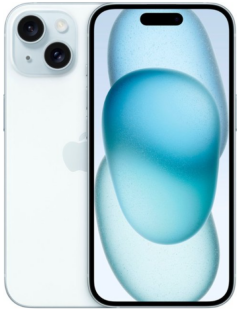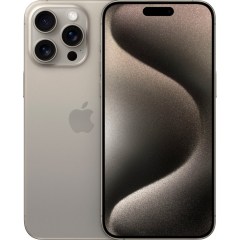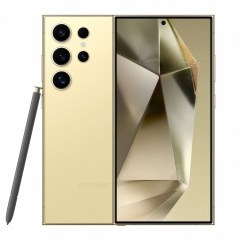BestReviews is reader-supported and may earn an affiliate commission. Details

For the price, the iPhone 15 packs a punch with a brighter screen, faster performance, breathtaking cameras, and a USB-C port, making it an excellent option for those who don't need the bleeding-edge features of the iPhone 15 Pro. It's durable, waterproof, and starts at a reasonable $799.
It’s equipped with a USB-C port, which means its charger is likely compatible with your other devices. Its processor is powerful and helps deliver impressive battery life. The iPhone 15’s 6.1-inch screen reaches the same brightness as the pricier 15 Pro.
It lacks an “always-on display.” It only has twin camera lenses compared to pricier models’ three lenses. It only supports a 60Hz refresh rate, which may negatively affect your gaming experience.
Google Pixel 7a packs several features found on smartphones that cost twice as much, including a powerful processor, smooth display and wireless charging. As you'd expect from a budget phone, it has minor shortcomings like a lack of a dedicated zoom lens, but overall, it's an outstanding device for the money that still takes excellent photos.
The Pixel 7a offers most features of the Pixel 7 but at a cheaper price point. It is also one of the few budget smartphones that supports wireless charging.
The screen is slightly dim, which hinders its use outdoors. It supports only 18-watt wired charging, which is slower than other Android devices that can fast-charge at 45 watts.

The reasonably priced Samsung Galaxy S24 offers an elegant design, powerful chip, capable camera setup and beautiful AMOLED display, making it the top choice for buyers under $1,000. Despite offering even longer battery life, it sports an immersive and brighter 6.2-inch screen and a higher-resolution selfie camera compared to its predecessor.
The S24 is the first smartphone that can upload HDR photos to Instagram. Harnessing the power of AI, the S24 provides foreign language interpretation during calls and can more easily edit images and videos.
The design hasn’t changed significantly from the Galaxy S23. However, it has a flatter frame that makes the device more comfortable to hold.

With its 14-hour battery life, incredible camera system, and titanium build, the iPhone 15 Pro Max is the best phone for people who want the most remarkable features and best performance. However, it’ll cost you a pretty penny! Fortunately, it packs 256 GB of onboard storage space.
Features include an always-on display with an impressively fast refresh rate, a lightweight but durable titanium build, a customizable side “Action” button, the fastest processor, and the best cameras on an iPhone yet.
It’s a $200-plus price increase to opt for an iPhone 15 Pro over the base model.

Our extensive evaluation found that the Samsung Galaxy S24 Ultra stands out with its top-tier hardware, including a larger and sharper screen, premium titanium build, integrated S Pen stylus and superior camera setup. It delivers outstanding battery life and fast performance and is the Android phone to buy if you want the latest and greatest device possible.
Our tests found the phone will easily last two days on a single charge, even with heavy use. This smartphone packs an improved 50-megapixel sensor that delivers superior image quality. Its screen is bright, smoother and more vibrant than the competition. Long-term testing proved the S24 Ultra easily handles even the most processor-intensive tasks.
Samsung did away with the 10x optical zoom previously featured on the S23 Ultra, replacing it with a 5x optical zoom. Our tests revealed that the S24 Ultra is uncomfortable to hold one-handed and use for extended periods. It lacks Qi2 wireless charging.

We recommend these products based on an intensive research process that's designed to cut through the noise and find the top products in this space. Guided by experts, we spend hours looking into the factors that matter, to bring you these selections.

Whether you want an iPhone or an Android smartphone, there are several things to consider before buying a new phone.
The more features a phone has to offer, the more expensive it typically is. For example, phones with more advanced multi-lens setups generally are more expensive than those with a single-lens camera. Phones with powerful processors are also pricier than those with mid-tier processors since they offer superior performance.
Other important considerations include screen size (especially if you want it to fit comfortably in your pocket), battery life and the right amount of storage for your needs (128 gigabytes is ideal if you take a lot of photos).
We researched phones and found the Apple iPhone 14 Pro Max to be the best. It’s perfect for those who want a fast phone with a large screen. The processor enables efficient multitasking while running high-powered apps, and the camera system takes excellent photos and records videos with exceptional clarity and detail. But there are many great phones out there to suit the specific needs of any user.
The iPhone 15 is the best smartphone for most people. It comes in two sizes: a 6.1-inch model and a 6.7-inch Plus model. Both models are powered by Apple's signature A16 Bionic chip, used in last year's iPhone 14 Pro. The experts we consulted are confident the processor should offer noticeable performance improvements for users upgrading from phones released a few years ago.
It boasts a dazzling, brighter display thanks to improved OLED technology. This makes reading and replying to messages a breeze, even under harsh sunlight. The iPhone 15 also packs a punch when it comes to durability. Its aircraft-grade aluminum frame and Ceramic Shield screen make it one of the toughest smartphones on the market.
If battery life is crucial for you, we recommend opting for the larger iPhone 15 Plus, which promises several days of battery life before you need to charge it.
The Google Pixel 7a is the best phone you can buy for under $500, offering features like wireless charging and an IP67 rating for dust and water resistance that are typically only found in pricier smartphones. The device is powered by Google's Tensor G2 processor (the same found in the more expensive Pixel 7 and 7 Pro devices), so it's reliable and has no problem juggling multiple apps simultaneously.
The Pixel 7a is equipped with a vibrant, 6.1-inch OLED display that offers a 90Hz refresh rate. For the non-tech-inclined, this means it's smooth and responsive. What our test team likes most about Google's Pixel line of smartphones is that they consistently run Google's latest version of Android and are guaranteed to receive updates and security patches for years to come. So, even if you don't have the flashiest, most expensive smartphone, you know you have one that will last several years and pack the latest features.
The Galaxy S24 and S24 Plus share the same suite of AI-infused features as their more expensive older brother, the Galaxy S24 Ultra, and they're powered by the zippy Snapdragon 8 Gen 3 processors. However, they strike a better balance between price, performance and feature set.
Useful GalaxyAI features include real-time call translation in 13 languages, allowing users to converse seamlessly during phone calls without needing separate apps. The translation extends to text messages and the default keyboard can quickly adjust the conversation tone.
Samsung's latest S24 and S24 Plus feature an adaptive refresh rate ranging from 1 Hz to 120 Hz, enhancing power efficiency and achieving a peak brightness of 2,600 nits for improved outdoor visibility and enhanced HDR visuals compared to the S23. While our testing team has not yet had the opportunity to try out the new S24 and S24 Plus, both devices look incredibly promising, and we are excited to compare them with other smartphones in their price range to determine if they live up to Samsung's stated claims.
The iPhone 15 Pro Max stands out as the ultimate choice for those seeking the crème de la crème of smartphones, boasting Apple’s premium A17 Pro chipset, a titanium build, and a remarkable 5x periscope zoom lens. With that being said, you’re probably asking yourself why we didn’t name it as our “Best of the Best” pick.
Although the device excels in design, photography, and performance, the iPhone 15 Pro Max might not be for everyone. It's unsuitable for those on a budget, given its high price point of $1,199, or for users who prefer compact devices because of its larger-than-average 6.7-inch display.
Regardless, this smartphone packs a punch and delivers an outstanding improvement over its predecessor with its 14-hour battery life, more capable cameras, durability and practical Action Button, which you can customize to open the camera, flashlight, voice recorder immediately or to run your favorite Shortcut.
The Galaxy S24 Ultra distinguishes itself from other flagship smartphones with its AI-powered features that make it easier to translate calls, edit images and video, and use your camera and the power of AI to learn more about your surroundings.
The device boasts a premium and highly durable titanium build, a spacious and ultra-bright 6.8-inch flat 1440p display, and a 50-megapixel 5x telephoto camera that will take your photos to the next level. The S24 Ultra is powered by Qualcomm's Snapdragon 8 Gen 3 processor, and when we tested it, we were blown away by its performance. Not only does it feel faster and more powerful than competing smartphones — especially when gaming — the processor helps the phone achieve incredible battery life. In fact, 52 hours passed before it needed charging.
It’s worth mentioning that this smartphone is one of the few that includes a responsive S Pen stylus you can use for gaming or alongside productivity apps for improved note-taking and markups. Our tester said it "felt good to use" and could automatically turn their handwriting to text.
Overall, if you prioritize battery life, display quality and gaming performance, you won't be disappointed.
If you don’t want to drop $800+ on the Samsung Galaxy S24, Google’s Pixel 8 is a solid alternative that offers similar features, including AI integration, a waterproof design, reverse wireless charging and a super twin camera array.
Artificial intelligence on the newest Pixel phone not only minimizes unwanted spam calls, improves language translations, and enhances responsiveness to voice commands but also enables the creation of flawless group shots by seamlessly combining multiple still images.
What our Test Team likes most about the Pixel 8 is that Google guarantees security updates for the device through Fall 2030. Overall, it is an outstanding Android phone that captures above-average-looking photos and delivers all-day battery life — even if you’re someone who is constantly glued to your smartphone.
For those searching for a phone that’ll set them apart from their loved ones, we recommend the unique Galaxy Z Flip 5 from Samsung. Compared to traditional, tablet-esque smartphones, the Z Flip 5G has a bendable display that lets you flip it close. This is handy for folks who want to keep focus and are looking for a device that isn’t as distracting.
We like that it still has a useful and informative 3.4-inch exterior display to catch quick glimpses of your messages, directions and more and use the phone more intentionally. It’s worth mentioning that the Z Flip 5 doesn’t deliver as long as battery life and traditional shaped smartphones. Regardless, it packs impressive cameras, sports a waterproof build and features the reliable Snapdragon 8 Gen 2 processor in Samsung’s Galaxy S23 phones.
As you may have noticed with our Galaxy Z Flip 5 recommendation, Samsung is known for pushing the envelope with its smartphone designs. The Galaxy Z Fold 5 is also a top-tier phone with an innovative folding design that lets you use it as a tablet, and although it’s pricey, there’s no denying it’s one of the most unique smartphones money can buy.
This phone is perfect for taking notes for work, consuming videos, taking Zoom calls and editing spreadsheets. The screen is large enough to offer a multi-view window function, and the rear camera has a 50-megapixel primary sensor for capturing photos with excellent color and clarity. However, with a price of around $1,500, it’s pricier than several laptops offering more functionality. But, if you want a foldable smartphone that works like a tablet and is much more portable and pocketable, the Z Fold 5 is an excellent choice.
Buying a phone upfront is expensive, but you have the advantage that you can switch carriers at any time, not to mention that you won’t have any added monthly costs. On the other hand, leasing a phone means fewer up-front costs but typically requires you to sign a two-year repayment contract that can be expensive to break.
Most people subscribe to one of the big three wireless carriers: AT&T, Verizon and T-Mobile. That’s usually the simplest way to go, but it’s not always the cheapest. If you want to save money, consider a provider who lets you pay monthly instead of requiring a contract. Mobile virtual network operators such as Boost Mobile and Cricket Wireless rent networks from the big three and then offer no-commitment contracts. The only catch is they sometimes don’t have the latest phones, so you’ll likely have to settle for an older model.
There are two main mobile operating systems for smartphones: Google’s Android mobile and Apple’s iOS. Most phones run Android because it’s designed for various hardware manufacturers, and iOS is only found on iPhones. Apple’s iPhones are more expensive but last longer than most Android phones and hold their resale value. They’re also designed to integrate seamlessly with other Apple products like MacBooks and Apple Watches. Android-based phones are more affordable and often see cutting-edge features, such as an ultrawide front camera, well before Apple devices. If you own other Apple devices, get an iPhone, but if money’s tight, it may be best to go with an Android phone.
A screen that’s too small can be frustrating since you may not be able to see enough at once. However, you don’t want one that’s too big either since you could end up with a phone that won’t fit in your pocket. Smartphone screens typically range from 4 to 7 inches, so consider which size you prefer most.
Even if you live most of your digital life in the cloud, you’ll still need local storage to keep your photos, videos and downloaded files. We recommend a minimum of 64 gigabytes of file storage, but if you take lots of pictures and videos, a minimum of 128 gigabytes is recommended.
Smartphone cameras have quickly evolved since getting a nearly pro-quality camera and taking frame-worthy photos with the right model is now possible. Phones with a multi-lens setup offer more features, such as zoom and various photography modes. If you’re into photography or take many pictures, a smartphone with a 12-megapixel or better camera is the way to go.
A phone with poor battery life can be frustrating since you’ll have to charge it often. Battery life varies depending on phone usage, but generally, you want a phone that offers at least 5 hours of screen time and a full day in standby mode.
You want your phone to be protected should it come in contact with water. Most phones have an Ingress Protection rating which indicates how waterproof and dustproof they are. For example, a phone with an IP67 is completely protected from dust particles and can withstand water submersion in one meter for up to 30 minutes. If you’re unsure what the IP rating indicates, a quick Google search will break it down.
A. The price of a brand-new phone varies depending on features, hardware and performance. Phones with lots of RAM, powerful processors and comprehensive camera systems can cost anywhere from $800 to $2,000. However, there are plenty of terrific budget-friendly phones for $400 to $800 that offer excellent performance and features for most users.
A. A locked phone is limited to one wireless carrier and cannot be used on other networks, while an unlocked phone can be used on multiple networks. Carriers can sometimes unlock locked phones once a contract is complete.
A. A screen protector is the easiest way to keep your phone’s screen from scratching, getting dinged or cracking. They’re the most cost-effective option for keeping your phone’s screen in good shape, especially considering replacement screens cost over $100.
A. We recommend backing up your photos to a cloud-based service like Google Photos, so you can easily access your older pictures with an app. A cloud-based storage app will save you from manually transferring every photo file from one device to another.
Get emails you’ll love.
Learn about the products you’re wondering if you should buy and get advice on using your latest purchases.
